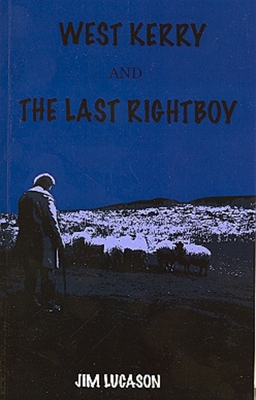West Kerry and The Last Rightboy
Michael O'Sullivan reviews West Kerry and The Last Rightboy, two Plays by Jim Lucason, Beag Moinear Press, ISBN 987-0-965046-62-6 , €

THE PUBLICATION of the texts of these two plays by Jim Lucason might invite reflection or speculation as to comparisons or contrasts between a written script and how it might materialise on the stage during actual performance.
Plays can of course be read, in private or in public, and some plays, as in the case of Closet drama, are written to be read.
But plays which purport to be dramatic or theatrical only fulfil their true purpose when they are acted out on a stage.
A text then can be regarded as the skeleton or essential framework of the thing, brought to life in a theatre through that fusion of language, acting, staging, lighting etc we call performance.
Judging by the general appearance of this volume it may be the case that the intention is simply to get the plays into print. There is nothing in the preface or the publisher's blurb or anywhere else to suggest that they have been or will be staged, though elementary stage directions do accompany the texts.
West Kerry is a humorous one act sketch set in 1916, where the 'hero' Timothy Michael O'Brien, a verbose and slightly raffish young man regales the locals at Reilly's pub with what may be tall stories of encounters he's made on a brief sojourn in faraway Dublin during the Easter rising, only to realise after all that there's no place like home.
The Last Rightboy' a more substantial piece, is set on a small tenant farm in county Mayo in 1860 and portrays the trials of a widow Maurya O'Connor and her twelve year old son as they struggle to survive and maintain their dignity in the face of impossible circumstances and the demands of a cunning and rapacious estate agent to whom they are continually in debt.
This piece is carefully crafted in terms of structure and movement, one or two of the encounters between the widow and the agent are memorable and touching and a sense of theme and purpose is maintained throughout.
It is not so easy however to envisage a wholly successful outcome if either of these scripts were to be produced as theatre pieces, since notwithstanding their formal merits they seem to lack the essential ingredients of the drama.
There is little in them for example in the way of dramatic force in the form of human conflict, neither is any real degree of inner tension generated or expectation raised which would in the course of things be resolved as the plots unfold.
In other words very little happens in either work other than what might emerge in the course of an evening's storytelling, and there I feel is where the real quality of these two works lie.
The realistic portrayal of strong, believable characters in the two pieces coupled with the author's obvious relish for language and local speech rhythms mark him out as a storyteller rather than a dramatist.
There remains however the question of language itself. Lucason writes in an idiom reminiscent of J M Synge, but his characters express themselves in a variety of speech not heard to my knowledge in any district of Ireland, least of all in west Kerry where his first piece is set.
Something similar has been said of Synge himself, but Synge's language, whatever its provenance as actual dialect was at all times both subtle and penetrating and his imagery rich with meaning and essentially poetic.
In other words, Synge's language was part and parcel of his dramas and inseparable from them. To attempt to introduce a heightened form of speech into a work of art simply for the sake of verbal colour seems contrived and overdone.
The effect is not improved either by the occasional use of words and sometimes grammatically incorrect phrases borrowed from the Irish language. That said however, what we have here is a couple of interesting and promising pieces of work and we look forward to future offerings from the same source.
Connolly Association, c/o RMT, Unity House, 39 Chalton Street, London, NW1 1JD
Copyright © 2009 Michael O'Sullivan

